RMIT University: Consumer Behavior Case Study on Body Idealisation
VerifiedAdded on 2023/01/10
|7
|2075
|33
Case Study
AI Summary
This case study analyzes consumer behavior in the context of body idealisation and diversity within the marketplace, focusing on the pressures to conform to idealised body forms, particularly for women, and the rise of resistance movements like fat activism. The analysis identifies two key consumer behavior theories: the Engel, Kollet, Blackwell (EKB) model and the psychoanalytic theory, to explain consumer decision-making processes and motivations. The study examines the dominant ideals of beauty in Western cultures, contrasting them with those in other cultural contexts, and assesses the impact of social media platforms like Instagram. It explores how fashion and beauty brands can engage with fat activists and larger consumers, examining resistance strategies and the potential impact of diverse body types in marketing communications. The paper concludes by discussing how marketers can leverage the EKB model and psychoanalytic theory to develop effective campaigns that appeal to a broader demographic, including those who have historically been underrepresented.
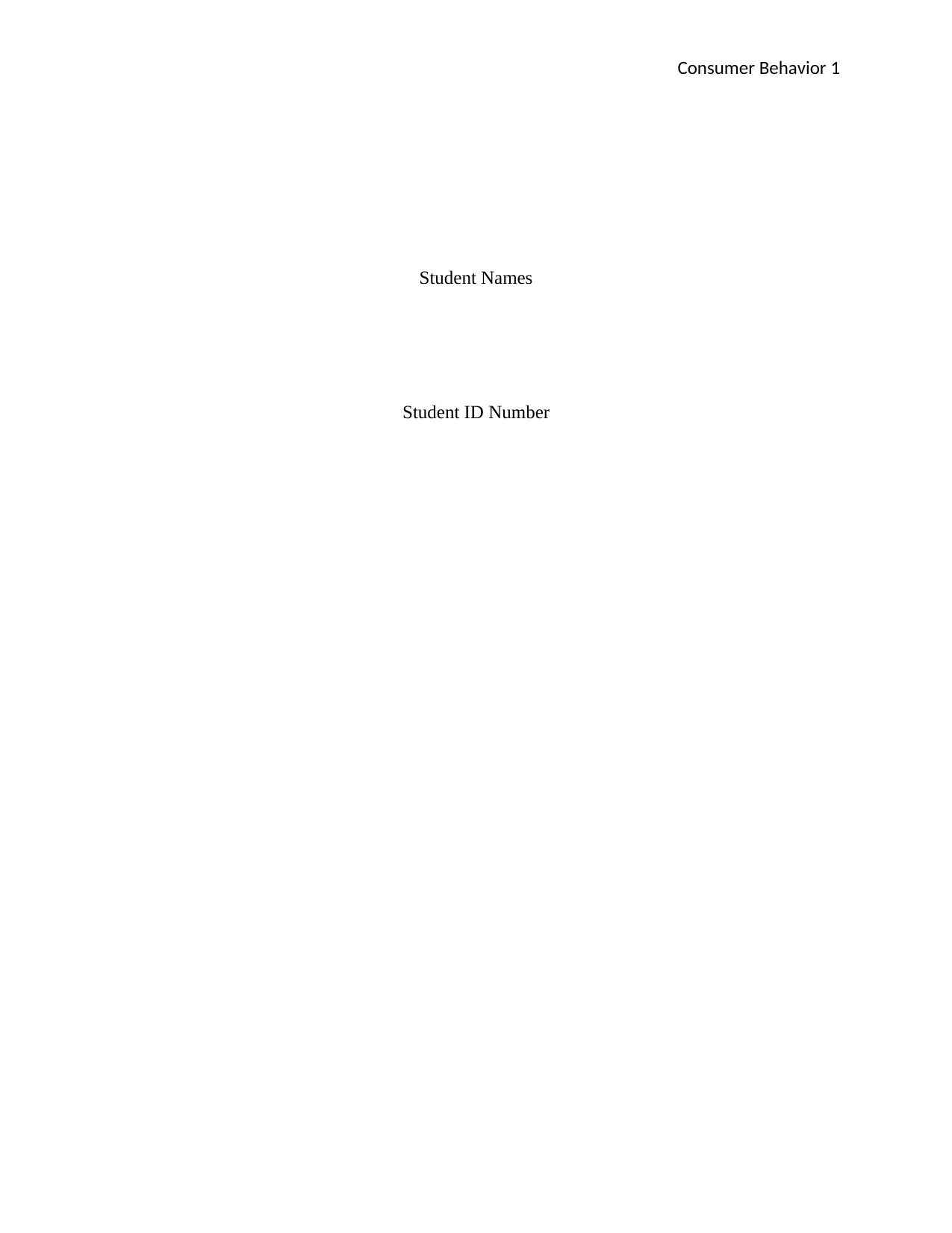
Consumer Behavior 1
Student Names
Student ID Number
Student Names
Student ID Number
Paraphrase This Document
Need a fresh take? Get an instant paraphrase of this document with our AI Paraphraser
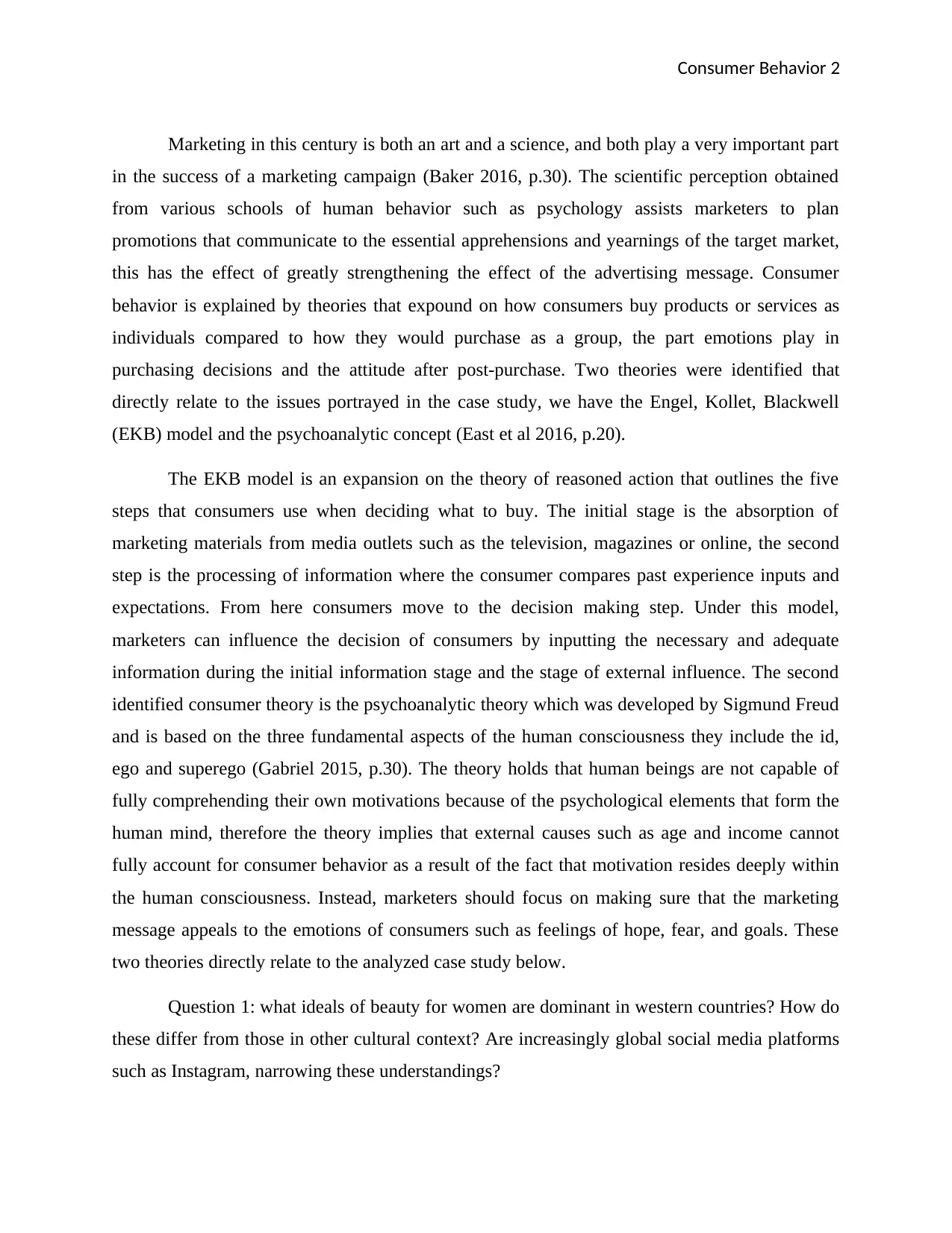
Consumer Behavior 2
Marketing in this century is both an art and a science, and both play a very important part
in the success of a marketing campaign (Baker 2016, p.30). The scientific perception obtained
from various schools of human behavior such as psychology assists marketers to plan
promotions that communicate to the essential apprehensions and yearnings of the target market,
this has the effect of greatly strengthening the effect of the advertising message. Consumer
behavior is explained by theories that expound on how consumers buy products or services as
individuals compared to how they would purchase as a group, the part emotions play in
purchasing decisions and the attitude after post-purchase. Two theories were identified that
directly relate to the issues portrayed in the case study, we have the Engel, Kollet, Blackwell
(EKB) model and the psychoanalytic concept (East et al 2016, p.20).
The EKB model is an expansion on the theory of reasoned action that outlines the five
steps that consumers use when deciding what to buy. The initial stage is the absorption of
marketing materials from media outlets such as the television, magazines or online, the second
step is the processing of information where the consumer compares past experience inputs and
expectations. From here consumers move to the decision making step. Under this model,
marketers can influence the decision of consumers by inputting the necessary and adequate
information during the initial information stage and the stage of external influence. The second
identified consumer theory is the psychoanalytic theory which was developed by Sigmund Freud
and is based on the three fundamental aspects of the human consciousness they include the id,
ego and superego (Gabriel 2015, p.30). The theory holds that human beings are not capable of
fully comprehending their own motivations because of the psychological elements that form the
human mind, therefore the theory implies that external causes such as age and income cannot
fully account for consumer behavior as a result of the fact that motivation resides deeply within
the human consciousness. Instead, marketers should focus on making sure that the marketing
message appeals to the emotions of consumers such as feelings of hope, fear, and goals. These
two theories directly relate to the analyzed case study below.
Question 1: what ideals of beauty for women are dominant in western countries? How do
these differ from those in other cultural context? Are increasingly global social media platforms
such as Instagram, narrowing these understandings?
Marketing in this century is both an art and a science, and both play a very important part
in the success of a marketing campaign (Baker 2016, p.30). The scientific perception obtained
from various schools of human behavior such as psychology assists marketers to plan
promotions that communicate to the essential apprehensions and yearnings of the target market,
this has the effect of greatly strengthening the effect of the advertising message. Consumer
behavior is explained by theories that expound on how consumers buy products or services as
individuals compared to how they would purchase as a group, the part emotions play in
purchasing decisions and the attitude after post-purchase. Two theories were identified that
directly relate to the issues portrayed in the case study, we have the Engel, Kollet, Blackwell
(EKB) model and the psychoanalytic concept (East et al 2016, p.20).
The EKB model is an expansion on the theory of reasoned action that outlines the five
steps that consumers use when deciding what to buy. The initial stage is the absorption of
marketing materials from media outlets such as the television, magazines or online, the second
step is the processing of information where the consumer compares past experience inputs and
expectations. From here consumers move to the decision making step. Under this model,
marketers can influence the decision of consumers by inputting the necessary and adequate
information during the initial information stage and the stage of external influence. The second
identified consumer theory is the psychoanalytic theory which was developed by Sigmund Freud
and is based on the three fundamental aspects of the human consciousness they include the id,
ego and superego (Gabriel 2015, p.30). The theory holds that human beings are not capable of
fully comprehending their own motivations because of the psychological elements that form the
human mind, therefore the theory implies that external causes such as age and income cannot
fully account for consumer behavior as a result of the fact that motivation resides deeply within
the human consciousness. Instead, marketers should focus on making sure that the marketing
message appeals to the emotions of consumers such as feelings of hope, fear, and goals. These
two theories directly relate to the analyzed case study below.
Question 1: what ideals of beauty for women are dominant in western countries? How do
these differ from those in other cultural context? Are increasingly global social media platforms
such as Instagram, narrowing these understandings?
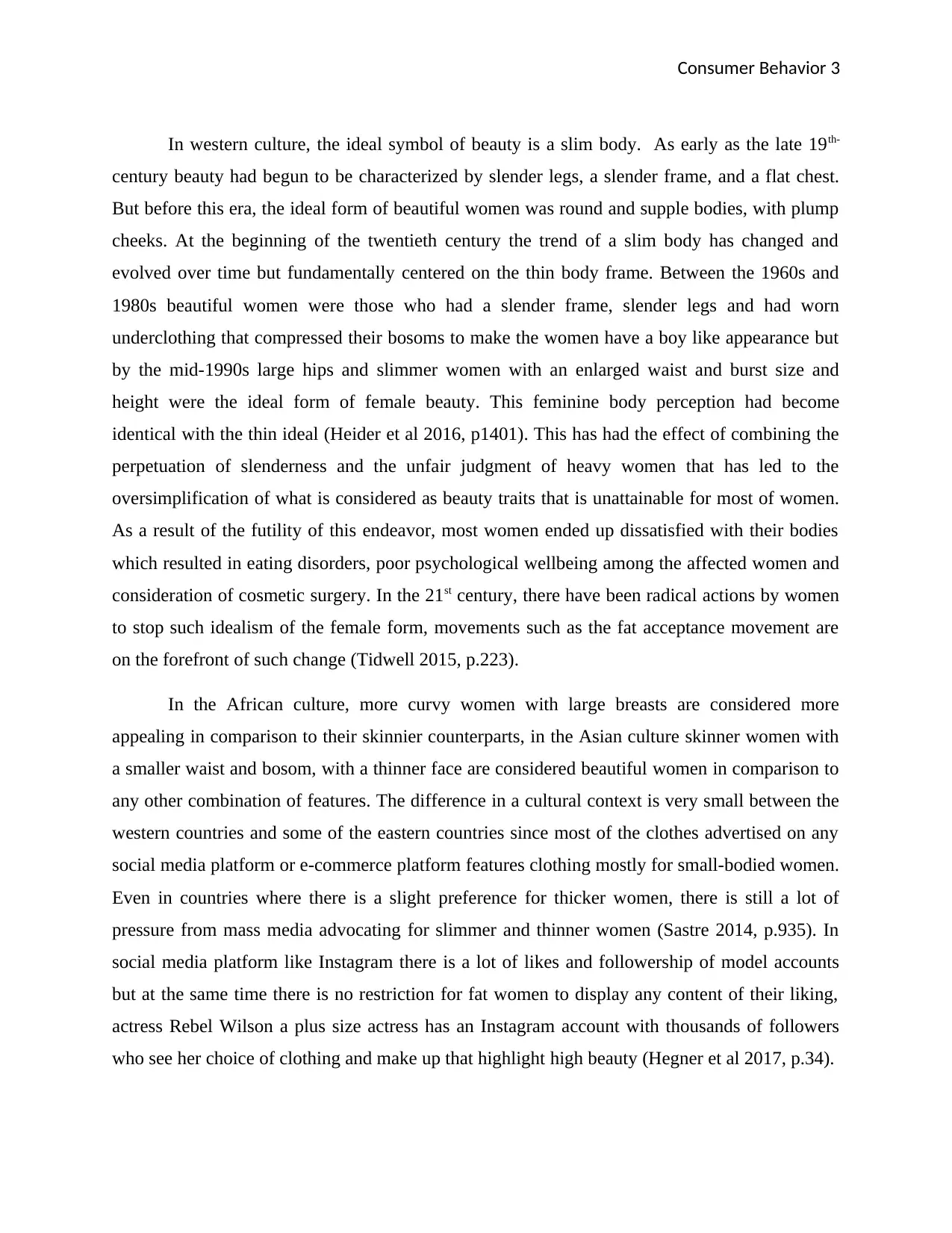
Consumer Behavior 3
In western culture, the ideal symbol of beauty is a slim body. As early as the late 19th-
century beauty had begun to be characterized by slender legs, a slender frame, and a flat chest.
But before this era, the ideal form of beautiful women was round and supple bodies, with plump
cheeks. At the beginning of the twentieth century the trend of a slim body has changed and
evolved over time but fundamentally centered on the thin body frame. Between the 1960s and
1980s beautiful women were those who had a slender frame, slender legs and had worn
underclothing that compressed their bosoms to make the women have a boy like appearance but
by the mid-1990s large hips and slimmer women with an enlarged waist and burst size and
height were the ideal form of female beauty. This feminine body perception had become
identical with the thin ideal (Heider et al 2016, p1401). This has had the effect of combining the
perpetuation of slenderness and the unfair judgment of heavy women that has led to the
oversimplification of what is considered as beauty traits that is unattainable for most of women.
As a result of the futility of this endeavor, most women ended up dissatisfied with their bodies
which resulted in eating disorders, poor psychological wellbeing among the affected women and
consideration of cosmetic surgery. In the 21st century, there have been radical actions by women
to stop such idealism of the female form, movements such as the fat acceptance movement are
on the forefront of such change (Tidwell 2015, p.223).
In the African culture, more curvy women with large breasts are considered more
appealing in comparison to their skinnier counterparts, in the Asian culture skinner women with
a smaller waist and bosom, with a thinner face are considered beautiful women in comparison to
any other combination of features. The difference in a cultural context is very small between the
western countries and some of the eastern countries since most of the clothes advertised on any
social media platform or e-commerce platform features clothing mostly for small-bodied women.
Even in countries where there is a slight preference for thicker women, there is still a lot of
pressure from mass media advocating for slimmer and thinner women (Sastre 2014, p.935). In
social media platform like Instagram there is a lot of likes and followership of model accounts
but at the same time there is no restriction for fat women to display any content of their liking,
actress Rebel Wilson a plus size actress has an Instagram account with thousands of followers
who see her choice of clothing and make up that highlight high beauty (Hegner et al 2017, p.34).
In western culture, the ideal symbol of beauty is a slim body. As early as the late 19th-
century beauty had begun to be characterized by slender legs, a slender frame, and a flat chest.
But before this era, the ideal form of beautiful women was round and supple bodies, with plump
cheeks. At the beginning of the twentieth century the trend of a slim body has changed and
evolved over time but fundamentally centered on the thin body frame. Between the 1960s and
1980s beautiful women were those who had a slender frame, slender legs and had worn
underclothing that compressed their bosoms to make the women have a boy like appearance but
by the mid-1990s large hips and slimmer women with an enlarged waist and burst size and
height were the ideal form of female beauty. This feminine body perception had become
identical with the thin ideal (Heider et al 2016, p1401). This has had the effect of combining the
perpetuation of slenderness and the unfair judgment of heavy women that has led to the
oversimplification of what is considered as beauty traits that is unattainable for most of women.
As a result of the futility of this endeavor, most women ended up dissatisfied with their bodies
which resulted in eating disorders, poor psychological wellbeing among the affected women and
consideration of cosmetic surgery. In the 21st century, there have been radical actions by women
to stop such idealism of the female form, movements such as the fat acceptance movement are
on the forefront of such change (Tidwell 2015, p.223).
In the African culture, more curvy women with large breasts are considered more
appealing in comparison to their skinnier counterparts, in the Asian culture skinner women with
a smaller waist and bosom, with a thinner face are considered beautiful women in comparison to
any other combination of features. The difference in a cultural context is very small between the
western countries and some of the eastern countries since most of the clothes advertised on any
social media platform or e-commerce platform features clothing mostly for small-bodied women.
Even in countries where there is a slight preference for thicker women, there is still a lot of
pressure from mass media advocating for slimmer and thinner women (Sastre 2014, p.935). In
social media platform like Instagram there is a lot of likes and followership of model accounts
but at the same time there is no restriction for fat women to display any content of their liking,
actress Rebel Wilson a plus size actress has an Instagram account with thousands of followers
who see her choice of clothing and make up that highlight high beauty (Hegner et al 2017, p.34).
⊘ This is a preview!⊘
Do you want full access?
Subscribe today to unlock all pages.

Trusted by 1+ million students worldwide
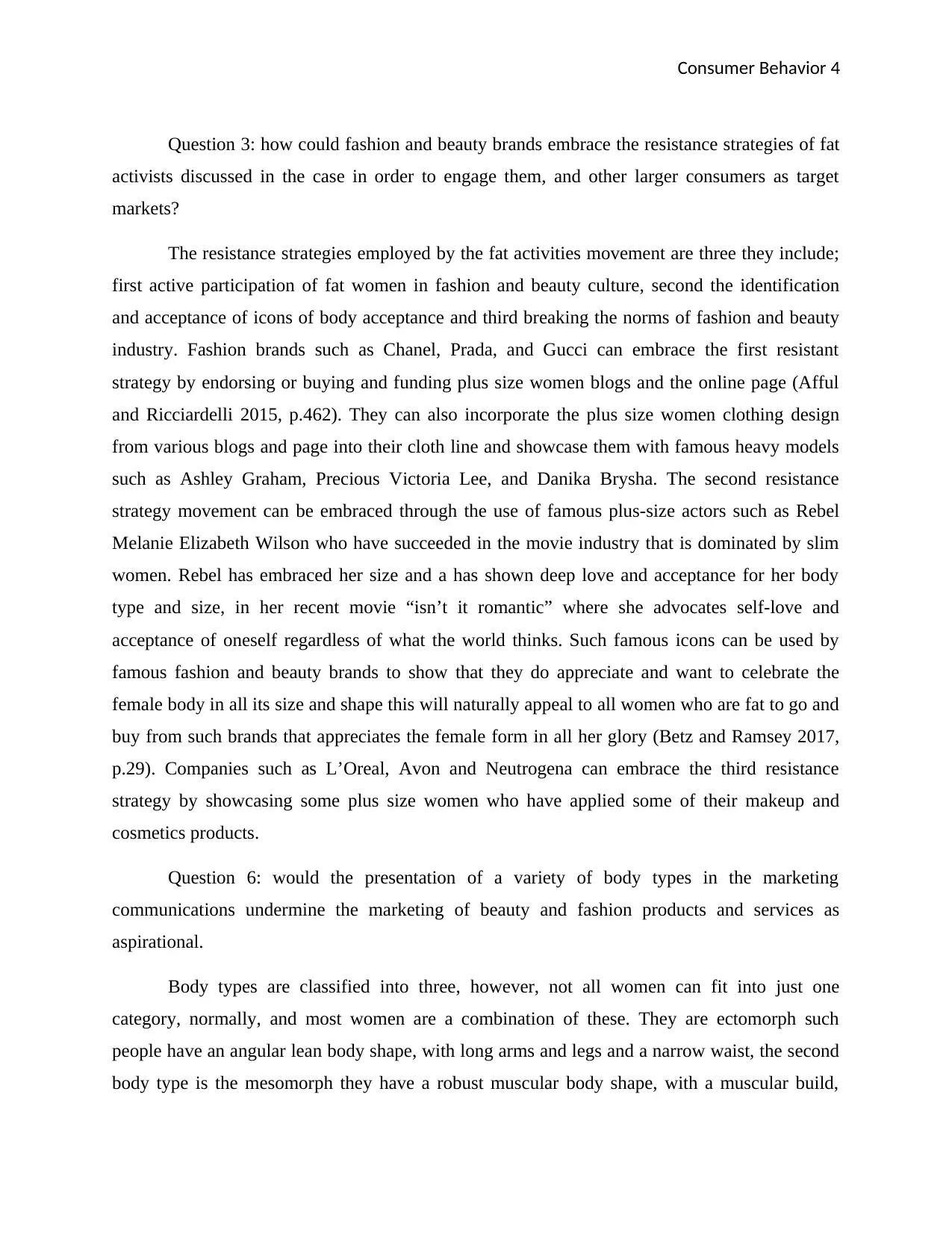
Consumer Behavior 4
Question 3: how could fashion and beauty brands embrace the resistance strategies of fat
activists discussed in the case in order to engage them, and other larger consumers as target
markets?
The resistance strategies employed by the fat activities movement are three they include;
first active participation of fat women in fashion and beauty culture, second the identification
and acceptance of icons of body acceptance and third breaking the norms of fashion and beauty
industry. Fashion brands such as Chanel, Prada, and Gucci can embrace the first resistant
strategy by endorsing or buying and funding plus size women blogs and the online page (Afful
and Ricciardelli 2015, p.462). They can also incorporate the plus size women clothing design
from various blogs and page into their cloth line and showcase them with famous heavy models
such as Ashley Graham, Precious Victoria Lee, and Danika Brysha. The second resistance
strategy movement can be embraced through the use of famous plus-size actors such as Rebel
Melanie Elizabeth Wilson who have succeeded in the movie industry that is dominated by slim
women. Rebel has embraced her size and a has shown deep love and acceptance for her body
type and size, in her recent movie “isn’t it romantic” where she advocates self-love and
acceptance of oneself regardless of what the world thinks. Such famous icons can be used by
famous fashion and beauty brands to show that they do appreciate and want to celebrate the
female body in all its size and shape this will naturally appeal to all women who are fat to go and
buy from such brands that appreciates the female form in all her glory (Betz and Ramsey 2017,
p.29). Companies such as L’Oreal, Avon and Neutrogena can embrace the third resistance
strategy by showcasing some plus size women who have applied some of their makeup and
cosmetics products.
Question 6: would the presentation of a variety of body types in the marketing
communications undermine the marketing of beauty and fashion products and services as
aspirational.
Body types are classified into three, however, not all women can fit into just one
category, normally, and most women are a combination of these. They are ectomorph such
people have an angular lean body shape, with long arms and legs and a narrow waist, the second
body type is the mesomorph they have a robust muscular body shape, with a muscular build,
Question 3: how could fashion and beauty brands embrace the resistance strategies of fat
activists discussed in the case in order to engage them, and other larger consumers as target
markets?
The resistance strategies employed by the fat activities movement are three they include;
first active participation of fat women in fashion and beauty culture, second the identification
and acceptance of icons of body acceptance and third breaking the norms of fashion and beauty
industry. Fashion brands such as Chanel, Prada, and Gucci can embrace the first resistant
strategy by endorsing or buying and funding plus size women blogs and the online page (Afful
and Ricciardelli 2015, p.462). They can also incorporate the plus size women clothing design
from various blogs and page into their cloth line and showcase them with famous heavy models
such as Ashley Graham, Precious Victoria Lee, and Danika Brysha. The second resistance
strategy movement can be embraced through the use of famous plus-size actors such as Rebel
Melanie Elizabeth Wilson who have succeeded in the movie industry that is dominated by slim
women. Rebel has embraced her size and a has shown deep love and acceptance for her body
type and size, in her recent movie “isn’t it romantic” where she advocates self-love and
acceptance of oneself regardless of what the world thinks. Such famous icons can be used by
famous fashion and beauty brands to show that they do appreciate and want to celebrate the
female body in all its size and shape this will naturally appeal to all women who are fat to go and
buy from such brands that appreciates the female form in all her glory (Betz and Ramsey 2017,
p.29). Companies such as L’Oreal, Avon and Neutrogena can embrace the third resistance
strategy by showcasing some plus size women who have applied some of their makeup and
cosmetics products.
Question 6: would the presentation of a variety of body types in the marketing
communications undermine the marketing of beauty and fashion products and services as
aspirational.
Body types are classified into three, however, not all women can fit into just one
category, normally, and most women are a combination of these. They are ectomorph such
people have an angular lean body shape, with long arms and legs and a narrow waist, the second
body type is the mesomorph they have a robust muscular body shape, with a muscular build,
Paraphrase This Document
Need a fresh take? Get an instant paraphrase of this document with our AI Paraphraser
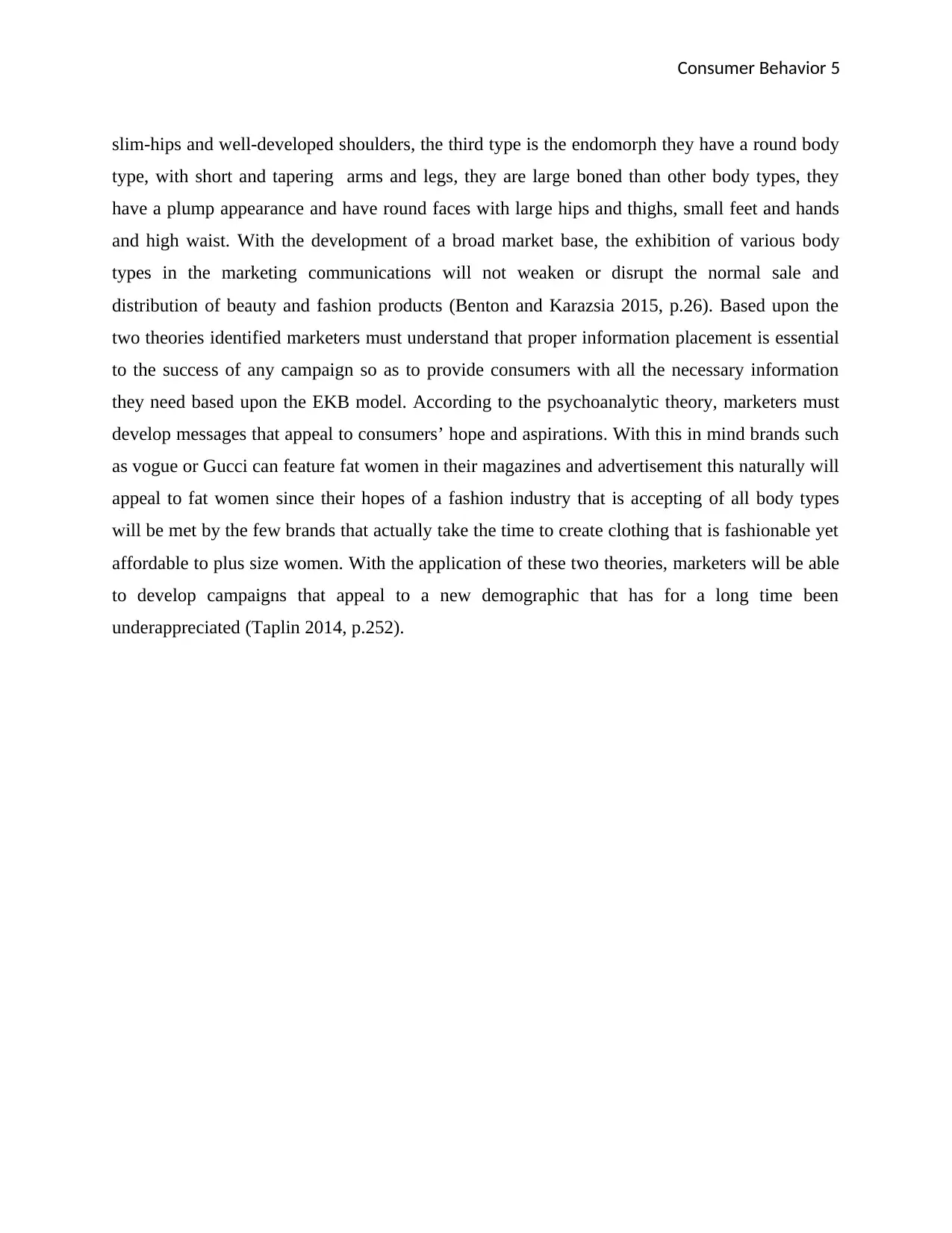
Consumer Behavior 5
slim-hips and well-developed shoulders, the third type is the endomorph they have a round body
type, with short and tapering arms and legs, they are large boned than other body types, they
have a plump appearance and have round faces with large hips and thighs, small feet and hands
and high waist. With the development of a broad market base, the exhibition of various body
types in the marketing communications will not weaken or disrupt the normal sale and
distribution of beauty and fashion products (Benton and Karazsia 2015, p.26). Based upon the
two theories identified marketers must understand that proper information placement is essential
to the success of any campaign so as to provide consumers with all the necessary information
they need based upon the EKB model. According to the psychoanalytic theory, marketers must
develop messages that appeal to consumers’ hope and aspirations. With this in mind brands such
as vogue or Gucci can feature fat women in their magazines and advertisement this naturally will
appeal to fat women since their hopes of a fashion industry that is accepting of all body types
will be met by the few brands that actually take the time to create clothing that is fashionable yet
affordable to plus size women. With the application of these two theories, marketers will be able
to develop campaigns that appeal to a new demographic that has for a long time been
underappreciated (Taplin 2014, p.252).
slim-hips and well-developed shoulders, the third type is the endomorph they have a round body
type, with short and tapering arms and legs, they are large boned than other body types, they
have a plump appearance and have round faces with large hips and thighs, small feet and hands
and high waist. With the development of a broad market base, the exhibition of various body
types in the marketing communications will not weaken or disrupt the normal sale and
distribution of beauty and fashion products (Benton and Karazsia 2015, p.26). Based upon the
two theories identified marketers must understand that proper information placement is essential
to the success of any campaign so as to provide consumers with all the necessary information
they need based upon the EKB model. According to the psychoanalytic theory, marketers must
develop messages that appeal to consumers’ hope and aspirations. With this in mind brands such
as vogue or Gucci can feature fat women in their magazines and advertisement this naturally will
appeal to fat women since their hopes of a fashion industry that is accepting of all body types
will be met by the few brands that actually take the time to create clothing that is fashionable yet
affordable to plus size women. With the application of these two theories, marketers will be able
to develop campaigns that appeal to a new demographic that has for a long time been
underappreciated (Taplin 2014, p.252).
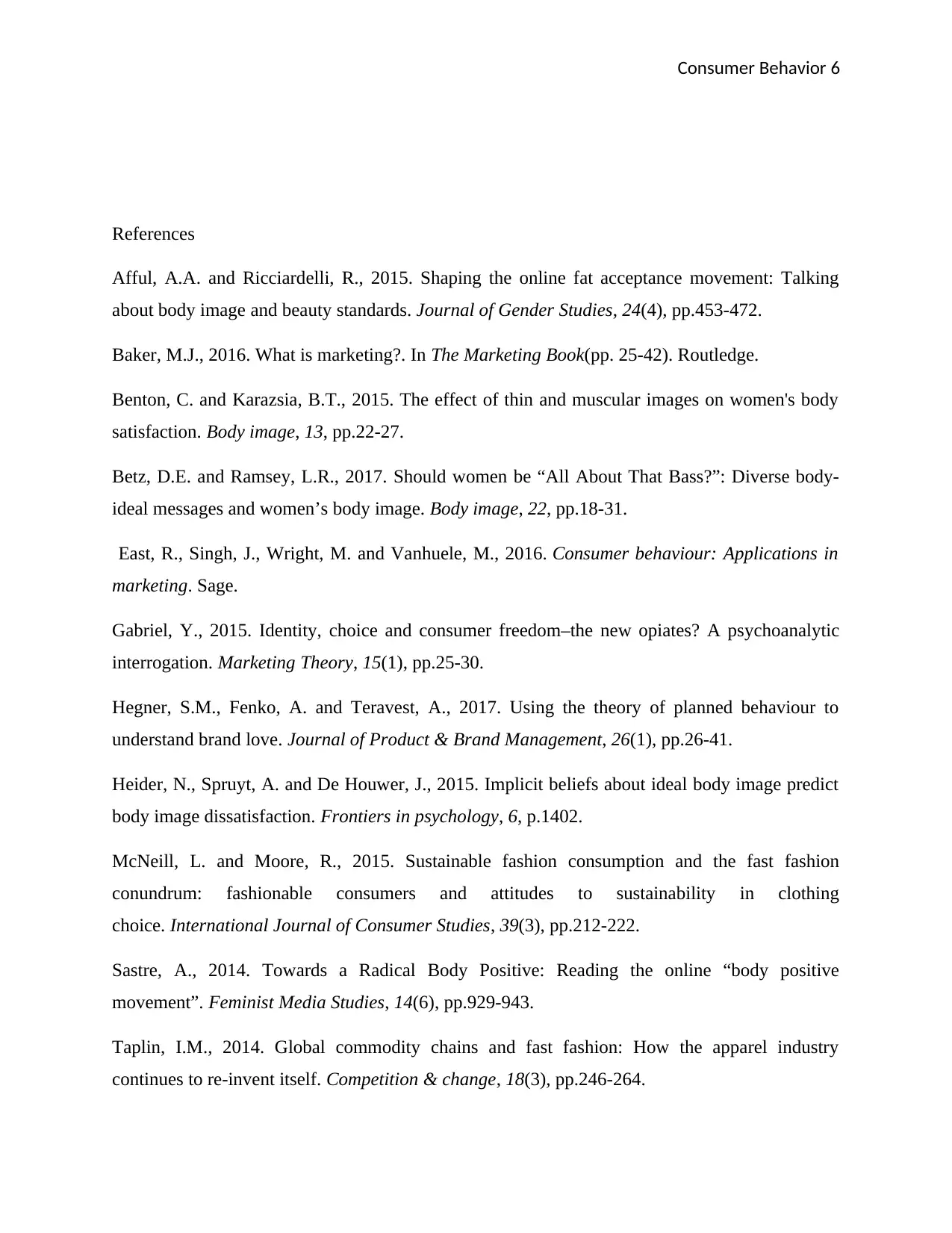
Consumer Behavior 6
References
Afful, A.A. and Ricciardelli, R., 2015. Shaping the online fat acceptance movement: Talking
about body image and beauty standards. Journal of Gender Studies, 24(4), pp.453-472.
Baker, M.J., 2016. What is marketing?. In The Marketing Book(pp. 25-42). Routledge.
Benton, C. and Karazsia, B.T., 2015. The effect of thin and muscular images on women's body
satisfaction. Body image, 13, pp.22-27.
Betz, D.E. and Ramsey, L.R., 2017. Should women be “All About That Bass?”: Diverse body-
ideal messages and women’s body image. Body image, 22, pp.18-31.
East, R., Singh, J., Wright, M. and Vanhuele, M., 2016. Consumer behaviour: Applications in
marketing. Sage.
Gabriel, Y., 2015. Identity, choice and consumer freedom–the new opiates? A psychoanalytic
interrogation. Marketing Theory, 15(1), pp.25-30.
Hegner, S.M., Fenko, A. and Teravest, A., 2017. Using the theory of planned behaviour to
understand brand love. Journal of Product & Brand Management, 26(1), pp.26-41.
Heider, N., Spruyt, A. and De Houwer, J., 2015. Implicit beliefs about ideal body image predict
body image dissatisfaction. Frontiers in psychology, 6, p.1402.
McNeill, L. and Moore, R., 2015. Sustainable fashion consumption and the fast fashion
conundrum: fashionable consumers and attitudes to sustainability in clothing
choice. International Journal of Consumer Studies, 39(3), pp.212-222.
Sastre, A., 2014. Towards a Radical Body Positive: Reading the online “body positive
movement”. Feminist Media Studies, 14(6), pp.929-943.
Taplin, I.M., 2014. Global commodity chains and fast fashion: How the apparel industry
continues to re-invent itself. Competition & change, 18(3), pp.246-264.
References
Afful, A.A. and Ricciardelli, R., 2015. Shaping the online fat acceptance movement: Talking
about body image and beauty standards. Journal of Gender Studies, 24(4), pp.453-472.
Baker, M.J., 2016. What is marketing?. In The Marketing Book(pp. 25-42). Routledge.
Benton, C. and Karazsia, B.T., 2015. The effect of thin and muscular images on women's body
satisfaction. Body image, 13, pp.22-27.
Betz, D.E. and Ramsey, L.R., 2017. Should women be “All About That Bass?”: Diverse body-
ideal messages and women’s body image. Body image, 22, pp.18-31.
East, R., Singh, J., Wright, M. and Vanhuele, M., 2016. Consumer behaviour: Applications in
marketing. Sage.
Gabriel, Y., 2015. Identity, choice and consumer freedom–the new opiates? A psychoanalytic
interrogation. Marketing Theory, 15(1), pp.25-30.
Hegner, S.M., Fenko, A. and Teravest, A., 2017. Using the theory of planned behaviour to
understand brand love. Journal of Product & Brand Management, 26(1), pp.26-41.
Heider, N., Spruyt, A. and De Houwer, J., 2015. Implicit beliefs about ideal body image predict
body image dissatisfaction. Frontiers in psychology, 6, p.1402.
McNeill, L. and Moore, R., 2015. Sustainable fashion consumption and the fast fashion
conundrum: fashionable consumers and attitudes to sustainability in clothing
choice. International Journal of Consumer Studies, 39(3), pp.212-222.
Sastre, A., 2014. Towards a Radical Body Positive: Reading the online “body positive
movement”. Feminist Media Studies, 14(6), pp.929-943.
Taplin, I.M., 2014. Global commodity chains and fast fashion: How the apparel industry
continues to re-invent itself. Competition & change, 18(3), pp.246-264.
⊘ This is a preview!⊘
Do you want full access?
Subscribe today to unlock all pages.

Trusted by 1+ million students worldwide
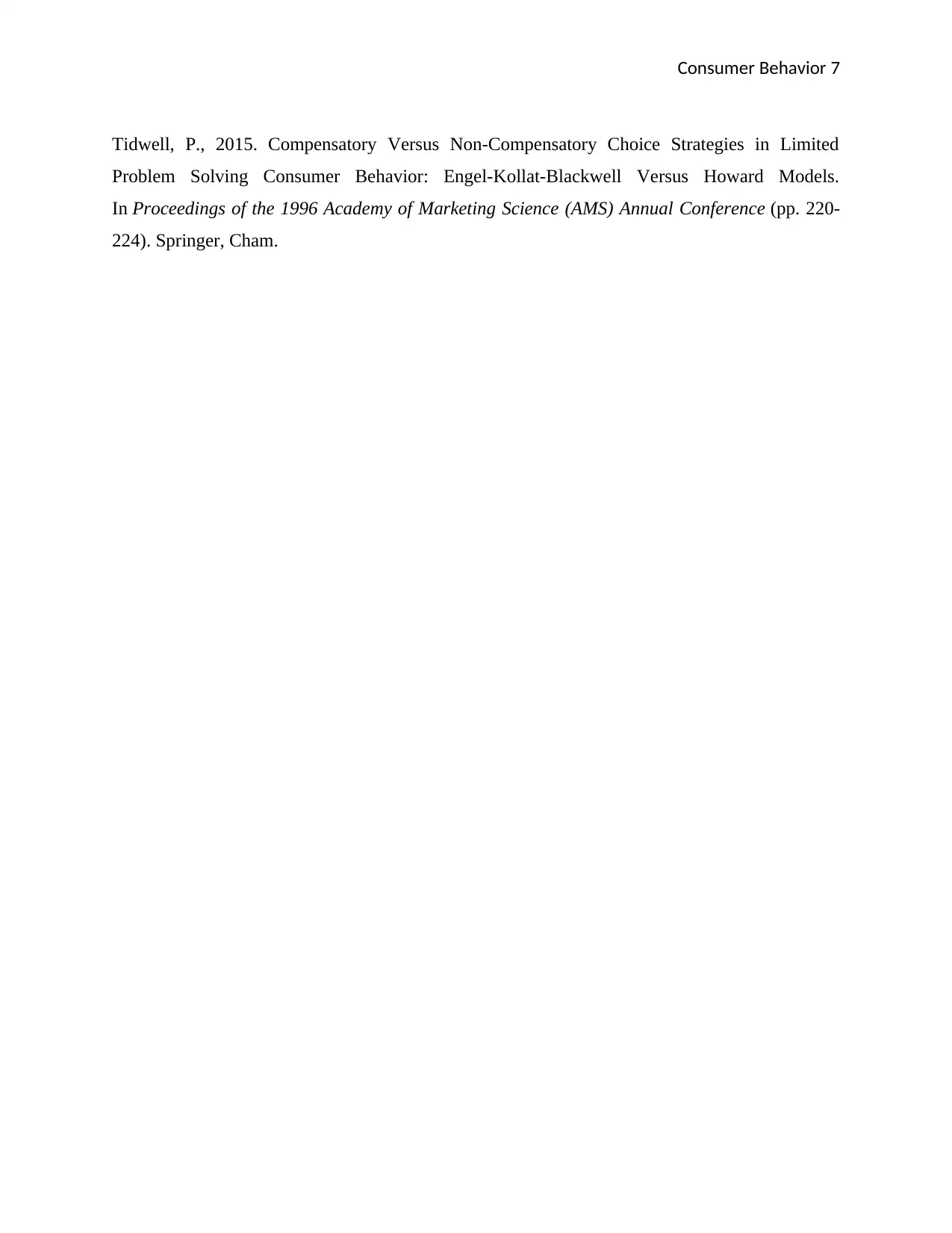
Consumer Behavior 7
Tidwell, P., 2015. Compensatory Versus Non-Compensatory Choice Strategies in Limited
Problem Solving Consumer Behavior: Engel-Kollat-Blackwell Versus Howard Models.
In Proceedings of the 1996 Academy of Marketing Science (AMS) Annual Conference (pp. 220-
224). Springer, Cham.
Tidwell, P., 2015. Compensatory Versus Non-Compensatory Choice Strategies in Limited
Problem Solving Consumer Behavior: Engel-Kollat-Blackwell Versus Howard Models.
In Proceedings of the 1996 Academy of Marketing Science (AMS) Annual Conference (pp. 220-
224). Springer, Cham.
1 out of 7
Your All-in-One AI-Powered Toolkit for Academic Success.
+13062052269
info@desklib.com
Available 24*7 on WhatsApp / Email
![[object Object]](/_next/static/media/star-bottom.7253800d.svg)
Unlock your academic potential
Copyright © 2020–2025 A2Z Services. All Rights Reserved. Developed and managed by ZUCOL.